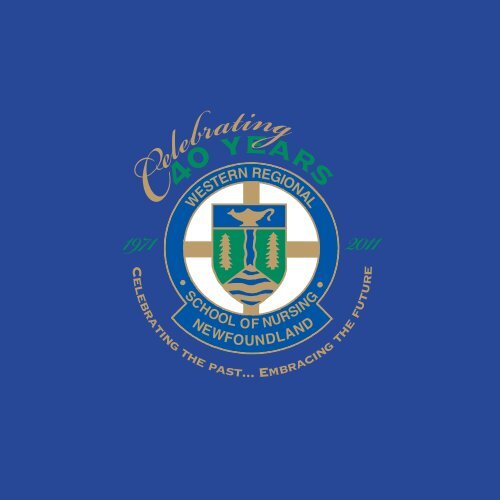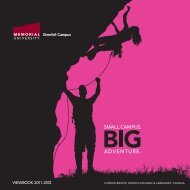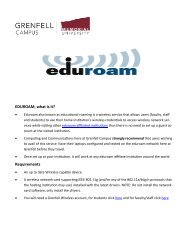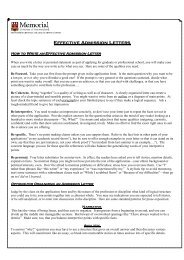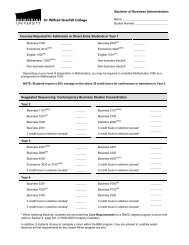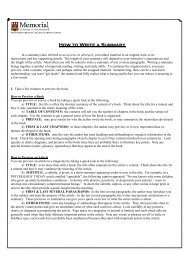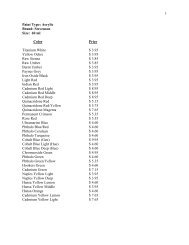40th Anniversary Souvenir Book - Sir Wilfred Grenfell College ...
40th Anniversary Souvenir Book - Sir Wilfred Grenfell College ...
40th Anniversary Souvenir Book - Sir Wilfred Grenfell College ...
You also want an ePaper? Increase the reach of your titles
YUMPU automatically turns print PDFs into web optimized ePapers that Google loves.
2<br />
CONGRATULATIONS FROM<br />
THE MINISTER OF HEALTH AND COMMUNITY SERVICES<br />
As the Minister of Health and Community Services, I am very pleased to congratulate<br />
Western Regional School of Nursing on its <strong>40th</strong> anniversary.<br />
The Government of Newfoundland and Labrador recognizes the important role that<br />
Western Regional School of Nursing plays in educating the nurses who will play such an<br />
important role in our province’s health care system.<br />
In recognition of the invaluable contribution that nurses make to the health care system<br />
in Newfoundland and Labrador, our government has created more full-time RN and LPN<br />
positions to meet the need for increased services for home care, public health and other<br />
areas, and we have placed additional nurse practitioners in emergency rooms to enable us to more fully meet the needs<br />
of patients.<br />
Our government is proud of Western Regional School of Nursing and its graduates for the impact made on the health<br />
and well being of the residents of our province and in particular those living in the western region. Our government has<br />
supported health care and nursing in the western region.<br />
On behalf of the Government of Newfoundland and Labrador, I want to thank Western Regional School of Nursing for its<br />
contribution to Newfoundland and Labrador and extend best wishes for an exciting celebration.<br />
Honourable Jerome Kennedy, QC<br />
Minister of Health and Community Services
3<br />
CONGRATULATIONS FROM<br />
THE PRESIDENT AND CEO OF WESTERN HEALTH<br />
“Celebrating the Past, Embracing the Future!” is an appropriate theme for<br />
Western Regional School of Nursing as it celebrates its <strong>40th</strong> anniversary. On behalf of<br />
Western Health, I convey my sincere appreciation to the dedicated faculty,<br />
management and staff of Western Regional School of Nursing for their valuable<br />
contributions in improving the health and well being of the people of our province.<br />
The more than 1,825 graduates of Western Regional School of Nursing have made<br />
significant contributions not only to Western Health, but also to our communities, our<br />
province, our country, and even worldwide, working in many varied positions. They<br />
have truly made a difference to the health and well being of individuals, families and<br />
communities. For their contribution, we are truly proud.<br />
I look forward to the future as Western Regional School of Nursing continues to respond to the needs of the health and<br />
community services system and contributes to the health and well being of the people of our province.<br />
Again, congratulations on achieving such an important milestone.<br />
Susan Gillam, PhD<br />
President and CEO Western Health
4<br />
CONGRATULATIONS FROM<br />
THE VICE-PRESIDENT OF GRENFELL CAMPUS<br />
On behalf of <strong>Grenfell</strong> Campus, Memorial University of Newfoundland, I am very pleased<br />
to recognize this milestone in the development of Western Regional School of Nursing.<br />
We at <strong>Grenfell</strong> are proud of our continuing association with the nursing school through<br />
the BN (Collaborative) Program. Since the early days of Memorial’s west coast campus we<br />
have had connections with the school of nursing; the institutions’ leaders have always<br />
sought to establish pathways that would bring them closer together. As the nursing<br />
school’s diploma program has transformed into the bachelor of nursing we now offer<br />
collaboratively, so too has our relationship flourished.<br />
We look forward to further transforming our affiliation to one that officially recognizes Western Regional School of<br />
Nursing as a rightful part of <strong>Grenfell</strong> Campus. In the future, we will build on the already healthy collaborations that exist<br />
with respect to teaching, research and program delivery. One day, our nursing colleagues and students will have a<br />
permanent, physical home on <strong>Grenfell</strong> Campus. This is an exciting time.<br />
And so, congratulations on 40 years of providing excellent nursing instruction in Corner Brook, and on many more to<br />
come, within our <strong>Grenfell</strong> community.<br />
Mary Bluechardt, PhD<br />
Vice-President, <strong>Grenfell</strong> Campus, Memorial University of Newfoundland
5<br />
CONGRATULATIONS FROM THE PRESIDENT OF<br />
NEWFOUNDLAND AND LABRADOR‘S NURSES‘ UNION<br />
Throughout its 40-year history, the Western Regional School of Nursing (WRSON) has<br />
contributed greatly to nursing and the improvement of health in Newfoundland and<br />
Labrador. It is a great pleasure to recognize and congratulate the WRSON faculty, staff,<br />
students and alumni on this significant anniversary.<br />
Starting with just 39 students in 1969, WRSON has grown exponentially in size and scope.<br />
Through its teaching, research, scholarship, administration and practice, WRSON has<br />
become a leader in its discipline and now educates over 200 nursing students each year.<br />
Together with the Centre for Nursing Studies and the Memorial University’s School of Nursing, WRSON offers educational<br />
programs that are responsive to diverse practice environments and the ever changing health needs of our society. WRSON<br />
graduates work in communities across our province, throughout Canada and beyond to improve health and quality life<br />
for individuals.<br />
On behalf of the Newfoundland and Labrador Nurses’ Union, I applaud you for your incredible work. I also look forward<br />
to the many years of continued success and achievement of WRSON faculty, staff and students.<br />
In solidarity,<br />
Debbie Forward<br />
President, Newfoundland and Labrador Nurses’ Union
6<br />
CONGRATULATIONS FROM<br />
THE PRESIDENT OF ARNNL<br />
On behalf of the Association of Registered Nurses of Newfoundland and Labrador<br />
(ARNNL), it is an honour and my pleasure to bring congratulations to Western Regional<br />
School of Nursing (WRSON) on its <strong>40th</strong> anniversary. As a graduate of this school of<br />
nursing, I can attest to the valuable educational opportunity it provides to the residents of<br />
the western region wishing to pursue a career in nursing. The school also brings value to<br />
communities in the region by educating people who are from the area – people who are<br />
more likely to accept employment in the region and make a valuable contribution to the<br />
health of people who mean the most to them and to the communities in which they live.<br />
Western Region School of Nursing has been well known over the years for graduating dedicated,<br />
high-quality nurses who are well prepared to deliver the care and services required by the population in the areas of<br />
promotion, prevention, curative, rehabilitative and supportive care. I am proud of the foundational education that I received<br />
at WRSON and felt well-prepared to function in my role as an RN, and to further my education as my career aspirations<br />
evolved. ARNNL applauds the past accomplishments of Western Region School of Nursing, and wishes you more success<br />
in the future as you continue to educate nurses who will meet the demands of the evolving health care system, and make a<br />
valuable contribution to improving the health of the population, particularly in the western region.<br />
Beverly White RN, MScN, CCHN (c)<br />
President, Association of Registered Nurses of Newfoundland & Labrador (ARNNL)
7<br />
Changing the face<br />
of nursing education<br />
Throughout the years Western Regional School of Nursing’s faculty<br />
and students have been a strong voice for nursing education,<br />
practice and research. Graduates of the school are compassionate<br />
and proficient nurses, having made great contributions to the health<br />
and well being of the communities where they live and work.<br />
History demonstrates Western Regional School of Nursing has<br />
successfully met many challenges over the past 40 years. In 1969<br />
students at Western Memorial Hospital School of Nursing took<br />
the first steps, not only for themselves, but for the school and for the<br />
community. They began a journey that continues today and will<br />
continue into the future, at <strong>Grenfell</strong> Campus, Memorial University.<br />
The Western Regional School of Nursing Crest<br />
was originally designed by Katherine Wells<br />
Daley, the first director of the school, and is<br />
based on the crest of the City of Corner Brook.<br />
The school’s colours, blue and green, symbolize<br />
the distinct features of the west coast<br />
region: the green forests and the blue waters of<br />
the Humber Arm. The golden edge about the<br />
crest signifies precious memories that bind us<br />
together in friendship and fellowship. The lamp<br />
symbolizes nursing and knowledge.<br />
“Celebrating the past... embracing the future”<br />
commemorates the <strong>40th</strong> anniversary of the<br />
school.<br />
From left, Jordan Audeau, Candace Campbell<br />
and Rebecca Nippard sport the nursing<br />
uniforms of today and days gone by.
8<br />
Building a school<br />
The idea to establish a school of nursing at the<br />
former Western Memorial Hospital was conceived<br />
in the early 1960s by a group of physicians,<br />
hospital administrators and community leaders in<br />
Corner Brook. At that time the hospital already<br />
had a Nursing Assistant Training School; however,<br />
there was a serious shortage of registered nurses<br />
in the area. The group successfully petitioned the<br />
provincial government for funding for a program<br />
for registered nurses.<br />
In 1966 government appointed a Nursing<br />
Education Advisory Board to oversee the<br />
development of the new program. In consultation<br />
with Memorial University of Newfoundland<br />
and the Association of Registered Nurses of<br />
Newfoundland (ARNN) (now the Association of<br />
Registered Nurses of Newfoundland and<br />
Labrador), the board decided that the program<br />
would be 24 months in length, reflecting changes<br />
in nursing education being introduced throughout<br />
the country. At that time, the decision to<br />
In August 1964 Premier J.R. Smallwood turned the sod for<br />
a new $2,000,000 nursing school and residence complex<br />
at the Christopher Fisher Division of the hospital.<br />
implement a two-year program was considered to be fairly innovative as most hospital diploma programs in Canada,<br />
including the three other diploma schools in the province, were 36 months in length. In September 1969 the first<br />
class of 39 students (37 women and two men) entered the program.
9<br />
Director, Katherine Wells Daley<br />
The school of nursing was a distinct and<br />
separate entity from the hospital. The school’s<br />
director reported to the hospital administrator,<br />
rather than to the director of Nursing Service.<br />
The school had a separate budget and<br />
maintained control over the students’ learning<br />
experiences. Nursing service and nursing<br />
education were viewed by faculty as<br />
complementary but distinct. As the school’s first<br />
director, Katherine Wells Daley, noted in her<br />
Six faculty members were hired in 1968.<br />
speech to the local Rotary Club early in 1971,<br />
“The purpose of a hospital is to care for the sick, and the purpose of education is to form<br />
minds” (The Western Star, 1971). This philosophical approach to nursing education was<br />
espoused by faculty throughout the years and remains important to the school to this day.<br />
Banding Ceremony: A dark green band replaced the original white band on the nursing students’ caps. This marked their successful<br />
transition from Nursing I to Nursing II.
10<br />
The school originally consisted of three classrooms, a<br />
fully equipped biology lab, three discussion rooms and<br />
two faculty offices. Nursing education was much less<br />
expensive in 1969. Room and board were provided free<br />
of charge in the nurses’ residence and students received<br />
a monthly stipend of $25.<br />
Accommodations for students were provided in the new<br />
residence located in the same building as the school of<br />
nursing. The residence was under the watchful eye of a<br />
supervisor and had receptionists on duty 24 hours a day.<br />
There was also a gymnasium and lounges available for<br />
student recreational use<br />
The only cost to students<br />
was for books and<br />
uniforms – about $200.<br />
TO BE ACCEPTED APPLICANTS<br />
WERE REQUIRED TO:<br />
n be 17 years old and in good health<br />
n have graduated with Grade 11<br />
or with “pass standing”<br />
n undergo an interview process with<br />
a selections committee to demonstrate<br />
that they had a “personality suited for<br />
the profession”<br />
Typical residence room
11<br />
Concepts vs. drills: Curriculum<br />
The curriculum was innovative and based on new concepts in nursing and<br />
education. Faculty believed in teaching principles of nursing rather than just<br />
drills and routine. The enthusiastic young director, Ms. Wells Daley, believed<br />
strongly in the program. She explained “in cutting down on ward duty, the<br />
nurses didn’t have as much experience – but they knew just as much and were<br />
better prepared to improvise and adjust to the varying circumstances they<br />
would face as graduate nurses” (The Western Star, 1969).<br />
In addition to nursing, students studied anatomy and physiology, microbiology,<br />
psychology, growth and development, sociology, nutrition, pharmacology,<br />
first-aid and communications. These courses were taught by guest lecturers<br />
from the hospital such as physicians, pharmacists and dietitians, as well as<br />
educators from the community.<br />
The original nursing uniform for women consisted of a pale green dress<br />
and distinctive nursing hat modelled after the hat worn by nurses<br />
in St. Thomas Hospital School of Nursing in London, England. Men<br />
wore plain white uniforms with a green stripe on the side of the pants.
12<br />
Coming into<br />
their own<br />
In December 1970 the new school of nursing and nurses’ residence<br />
were officially named Monaghan Hall. A ceremony was held to mark<br />
the many years of service of the well-respected Corner Brook family<br />
physician, Dr. T.T. Monaghan.<br />
On Sept. 3, 1971, the first class of 34 students proudly received their<br />
pins and graduation diplomas. It was a landmark event for the School<br />
and for the hospital. Ms. Wells Daley reflected these sentiments in her<br />
address to the graduates.<br />
“As the first graduates of Western Memorial Hospital School of<br />
Nursing you have helped make a dream become reality. You have<br />
shared with us the responsibility for laying a firm foundation upon<br />
which other classes may build in the future. The standards you have<br />
met will leave their mark in the years to come.”<br />
-Katherine Wells Daley<br />
The first graduating class
13<br />
Ms. Wells Daley tendered her resignation in 1971. After a series of<br />
short-term appointments, an energetic young director, Philomena<br />
Hawco Westby, was appointed in 1973. By 1974 there were 10 nursing<br />
faculty and three staff members employed at the school. New<br />
classrooms were added and enrollment was increased to 70 students<br />
per year.<br />
Ms. Hawco Westby brought her own ideas and aspirations<br />
for change to the school. One of the first things she did was to<br />
“modernize” the school uniform. Commencing in September 1974,<br />
women wore white dresses or pant suits with a green arm band and<br />
hats with corresponding bands: dark green in Nursing I, light green in<br />
Nursing II and white band in Nursing III. Student crests indicating the<br />
student’s position in the program were worn on the left sleeve. Men<br />
wore a similar white uniform with arm bands and crests.<br />
Philomena Hawco Westby<br />
SCHOOL OF NURSING<br />
DIRECTORS:<br />
n Katherine Wells Daley, 1968-1971<br />
n Edith Daniels, 1971-1972<br />
n Julia McIsaac, 1972 (April-June)<br />
n Nicole Pare, 1972-1986<br />
n Philomena Hawco Westby, 1973-1986<br />
n Annette Denny (acting) 1986-1987<br />
n Linda Norman-Robbins 1987-present
14<br />
Partnerships<br />
with <strong>Grenfell</strong><br />
A firm believer in the value of a liberal arts<br />
education for nurses, Ms. Hawco Westby<br />
approached Dr. Arthur Sullivan, the principal of<br />
Memorial University’s newly opened junior<br />
college in Corner Brook, with a view to offering<br />
a prerequisite year to students entering the<br />
nursing diploma program. She felt that if<br />
students completed courses such as English,<br />
biology and psychology before coming into<br />
nursing, faculty could then develop a highly<br />
structured two-year program with increased<br />
emphasis on clinical training. In addition,<br />
students would graduate with credits toward a<br />
bachelor’s degree. Dr. Sullivan supported the<br />
Paula Didham, left, received the Thompson Award<br />
for outstanding leadership and academic excellence.<br />
idea and these discussions marked the first steps in establishment of strong linkages between the school of nursing and<br />
the former <strong>Sir</strong> <strong>Wilfred</strong> <strong>Grenfell</strong> <strong>College</strong> (now <strong>Grenfell</strong> Campus, Memorial University of Newfoundland).<br />
EXTRACURRICULAR ACTIVITIES<br />
AND COMMUNITY SERVICE:<br />
n Student Council; provincial and national meetings<br />
n Fall fair to raise money for year book<br />
n Christmas concert for hospital patients and the general public<br />
n Red Cross Home Nursing Course for interested<br />
persons in the community<br />
n Faculty participated on provincial and national communities<br />
and travelled to conference and other nursing schools to<br />
observe new teaching and evaluation methods<br />
Ms. Hawco Westby was also instrumental in<br />
having university courses made available to<br />
faculty in Corner Brook. She introduced a<br />
policy stipulating that all faculty employed full<br />
time at the school must attain a minimum of<br />
two credits a year toward a bachelor’s degree.<br />
In order to facilitate the policy on continuing<br />
education another policy was introduced<br />
allowing faculty to be released to attend<br />
university classes during working hours,<br />
providing student instruction was not<br />
compromised.
15<br />
Changes to curriculum<br />
The ARNN felt that modifications like the suggested prerequisite year should encompass all schools of nursing and needed<br />
further study. While her proposal was not approved, Ms. Hawco Westby continued her work by spearheading<br />
the introduction of a new integrated curriculum, based on the two-year program at the Victoria General Hospital School<br />
of Nursing in Halifax, N.S. The new curriculum, designed to help prepare students for the new Canadian integrated<br />
registration exam, was introduced in 1975 and was the first integrated nursing program in the province.<br />
Ms. Hawco Westby subsequently developed a proposal to increase the length of the nursing program to 30 months, so<br />
that students received more clinical experience and were able to attain university credit courses. The proposal was<br />
approved by government, the ARNN and by the Nursing Education Advisory Board.<br />
In March 1982, 40 students graduated from the new 30-month program; for the first time, the school reported 100% pass<br />
on the registration (RN) exam.<br />
The school was visited by an approval team sponsored by the ARNN in February 1987. The assessment team<br />
determined that the school had met all provincial standards for nursing education and that it be granted full approval.<br />
In the late 1980s university credit courses in psychology, sociology and philosophy were added to the curriculum.<br />
By 1989, graduates of the program were receiving 15 university credit hours for these university courses and<br />
45 credit hours towards a bachelor’s degree in nursing.<br />
A new nurse’s cap was introduced in 1979.<br />
The change was initiated by students,<br />
who petitioned a more professional looking cap.
16<br />
Preceptorship<br />
Program<br />
In general it was agreed by faculty and their<br />
colleagues in nursing service that the new 30-month<br />
program was successful, in that graduates were<br />
better prepared for the realities of the work<br />
situation. However, it was felt that some<br />
improvements should be made to help ease the<br />
transition from student to graduate nurse. In 1983,<br />
Euna Ferguson, a faculty member in Nursing III,<br />
travelled to Ontario where several schools had<br />
instituted a new model for learning in the clinical<br />
setting. In 1984 she and other faculty members in<br />
Nursing III were responsible for instituting a formal<br />
Preceptorship Program – the first such program in<br />
the province. Nursing III faculty member Cathy<br />
Stratton developed a Preceptorship Manual to assist<br />
graduate nurses in their role as preceptors. The<br />
preceptorship clinical model and manual were<br />
subsequently adopted by the other schools of<br />
nursing in the province and continue to be used<br />
today to assist students in the transition to<br />
beginning practitioners.<br />
Over the years Western Health has provided strong administrative and clinical support for its school of nursing. In particular, the success<br />
of the Preceptorship Program is attributed to the dedicated registered nurses who tirelessly give of their time to assist students. In May<br />
2010, the school introduced an award to recognize a nursing unit whose staff had been exemplary preceptors for students. The nurses<br />
on Medicine 3B, under the leadership of Marie Hutchings King (who happens to be a graduate of the class of 1979) were the first<br />
to receive this award. Clockwise from top left at the 3B Nursing Station, Western Memorial Regional Hospital, are Heather Mousseau,<br />
fast-track BN student, Ruth Lamb, RN, Sarah Devereaux, BN student, and Cathy Pittman, RN.
17<br />
A new standard<br />
1982 was a landmark year for nursing<br />
education in Canada, as nurses at the Canadian<br />
Nurses Association’s biennial meeting held<br />
in St. John’s, NL, voted to accept the motion<br />
that by the year 2000 all nurses entering the<br />
workforce would have a baccalaureate degree<br />
in nursing. Under the direction of Ms. Hawco<br />
Westby, the school developed a five-year plan<br />
to have the required university courses for the<br />
bachelor of nursing degree made available for<br />
faculty in Corner Brook.<br />
Meanwhile the school continued to grow and<br />
Faculty members from the 1980s M. Farrell and A. Kawaja.<br />
develop new initiatives. By 1981 in response to<br />
the need for more registered nurses in the province, further renovations occurred at the school, more instructors were<br />
hired and enrollment was increased to 90 students in first year.<br />
REACHING OUT<br />
A partnership established with the<br />
Western District School Board<br />
developed and implemented a<br />
three-day Mini-Enrichment Course<br />
on the Health Professions for<br />
Junior High School students in<br />
he region. Here, three students<br />
get a first-hand look at maternal<br />
newborn nursing.
18<br />
REACHING OUT<br />
Shine on!<br />
In September 1973 students at the school first joined with other<br />
nursing students across the country to participate in Shinerama,<br />
a project that involved shining shoes to raise money for cystic<br />
fibrosis research. This event became a tradition at the school<br />
every fall and over the years hundreds of thousands of dollars<br />
have been raised for this worthy project. Today Shinerama<br />
continues at Western Regional School of Nursing and at<br />
<strong>Grenfell</strong> Campus, Memorial University.<br />
Dennis Boone helped the cause as his daughter Allison Boone,<br />
standing, and Kayla Carey gave his shoes a quick polishing.<br />
You‘re never too young<br />
Helen Nugent, who taught paediatrics at WRSON,<br />
introduced the Kindergarten Orientation Program in 1982.<br />
The goal of the program was to orientate children to the<br />
hospital setting in a fun, non-threatening manner, while<br />
providing nursing students with appropriate learning<br />
experiences with healthy children. This unique program<br />
was one of the first health-related community projects<br />
initiated and continues today as a valuable contribution to<br />
the community.<br />
Kindergarten orientation has become a regular program of<br />
Western School District and Western Regional School of Nursing.
19<br />
Toward the BN<br />
In August 1986, Ms. Hawco Westby<br />
resigned from the school. Annette<br />
Denny filled in as acting director until<br />
June of 1987 when Linda Norman-<br />
Robbins, a graduate of the master of<br />
science in nursing program at McGill<br />
University, was appointed to the position.<br />
In keeping with recommendations from<br />
the 1987 ARNN Approval Report, the<br />
school developed a new curriculum<br />
framework and adopted Roy’s<br />
Adaptation Model to guide students’<br />
nursing practice. Course content was<br />
organized around three foci: patients/<br />
clients adapting, those at risk, and those<br />
not adapting and using ineffective<br />
coping. The school also introduced<br />
its first quality assurance/ program<br />
evaluation plan in 1991.<br />
A computerized student database was developed during<br />
this period. In addition, test construction and test scoring<br />
software was purchased, allowing faculty to store,<br />
generate, score and analyze test questions in a much more<br />
efficient manner. The school’s first computer lab for students<br />
was also established. Faculty received computers for their<br />
offices and additional renovations occurred to classrooms<br />
and labs, which were equipped with audiovisual equipment.<br />
Under the leadership of Linda Norman-<br />
Robbins, faculty development,<br />
curriculum revision and computerization<br />
became priorities for the school<br />
during the early 1990s.<br />
In the early 1990s work was also underway<br />
to develop a preferred future<br />
nursing education model for the<br />
province to prepare graduates to meet<br />
the new entry requirements for the year<br />
2000. Ms. Norman-Robbins and faculty<br />
successfully lobbied government to<br />
ensure that the new baccalaureate<br />
program in nursing would be offered on<br />
the west coast. In January 1993 faculty<br />
member Anna-Marie Reinhart Alteen<br />
went to St John’s for six months to<br />
represent the school on the provincial<br />
committee chosen to collaboratively<br />
develop a new bachelor of nursing (BN)<br />
curriculum with faculty from the<br />
province’s other three diploma schools<br />
and Memorial University School of<br />
Nursing.<br />
In June 1991 a special graduation ceremony was held at<br />
<strong>Grenfell</strong> for the seven faculty members who were successful<br />
in meeting the requirements for the bachelor of nursing<br />
degree.<br />
Soon after Ms. Norman-Robbins began discussions with<br />
Memorial University’s School of Nursing regarding the<br />
availability of master-level courses for faculty by distance<br />
education.
20<br />
While work continued in the delivery of the 30-month diploma program, faculty members were very busy<br />
planning for implementation of the new BN (Collaborative) Program. Joint faculty meetings were held in June and<br />
August 1993 and in November 1994 to approve the new curriculum and develop course outlines for the new<br />
program. At the administrative level, the director was involved in developing a program budget and the Consortium<br />
Agreement which would govern the partnership between the Health Care Corporation of St. John’s for the Centre<br />
for Nursing Studies (CNS), Memorial University for MUN School of Nursing, and Western Health Care Corporation for<br />
Western Regional School of Nursing. In 1995 and 1996 Dorothy Andrews was seconded from faculty to be the first<br />
provincial consortium co-ordinator. During this time she was responsible for ensuring that the BN (Collaborative) Program<br />
curriculum package was prepared for approval by the Senate of Memorial University.<br />
Faculty and registered nurses receive<br />
bachelor of nursing degrees.
21<br />
Milestones<br />
In September 1996, the school accepted 50 students<br />
into the new BN (Collaborative) Program. It was a very<br />
proud day for faculty at the school of nursing and at<br />
<strong>Grenfell</strong>, and marked the culmination of many years<br />
of work and effort to ensure the future of nursing<br />
education on the west coast of the province. The<br />
program was designed so that students would<br />
complete 36 non-nursing credit hours at <strong>Grenfell</strong> and<br />
94 nursing credit hours at the school of nursing.<br />
Although the move to baccalaureate education was<br />
positive for the school, excitement was also mixed<br />
1996 saw the first class of BN students. Here, in their second year, from<br />
with sadness, as in 1998 the last class graduated from left, are Nicole Dennis, Raylene Hynes, Winter Payne, and Alma Lushman<br />
the diploma program. Around that time, the school<br />
said good bye to several excellent faculty members who had taught in the diploma program for many years.<br />
The transition from a diploma to degree program presented many challenges for faculty members in the new program.<br />
Academic issues were now governed by rules and regulations passed by the University Senate. The administration of<br />
the program was governed by a consortium and was operationalized through the work of a number of joint provincial<br />
committees. It was a steep learning curve; however, throughout the process, faculty and staff at <strong>Grenfell</strong> and the school’s<br />
collaborative partners, MUNSON and the CNS, gave a tremendous amount of assistance and support.<br />
By fall of 1999, 217 students were enrolled in the BN (Collaborative) Program. A Nursing Society was formed under the<br />
umbrella of <strong>Grenfell</strong>’s student union. Students became active members of the Canadian Nursing Students Association<br />
and proudly hosted the annual meeting of the Atlantic Students Nurses Association in Corner Brook. Several nursing<br />
students won university scholarships for academic excellence and awards for their involvement in university life, as<br />
nursing became integrated into the university setting.
22<br />
CELEBRATING 25 YEARS<br />
WRSON faculty at the 25th anniversary celebrations.<br />
New programs:<br />
In 1997, the school began offering a 12-month<br />
program for practical nurses, in collaboration with<br />
the CNS. This program was subsequently<br />
transferred to the <strong>College</strong> of the North Atlantic in<br />
2002. And in 2001, a BN fast-track option was<br />
offered. This option was designed by the BN<br />
(Collaborative) Program Consortium to allow<br />
students with a degree or with advanced<br />
standing to complete a baccalaureate in nursing<br />
in two years.<br />
In 1996 the school celebrated its 25th anniversary with<br />
students, graduates and colleagues from Western Health<br />
and <strong>Grenfell</strong>. The first director, Katherine Wells Daley, was<br />
a special guest at the ceremony. At that time the school<br />
changed its name to Western Regional School of Nursing<br />
(WRSON). This marked the transition from diploma to<br />
baccalaureate education and reflected the school’s regional<br />
mandate as a site for the delivery of the provincial BN<br />
(Collaborative) Program.
23<br />
REACHING OUT<br />
Serving<br />
Labrador<br />
In 1992 the school partnered with<br />
Labrador Community <strong>College</strong>,<br />
<strong>Grenfell</strong> Health Services, the<br />
Labrador Inuit Association, the<br />
Labrador Inuit Health Council<br />
and the Association of Registered<br />
Nurses of Newfoundland and<br />
Labrador (ARNNL) to develop and<br />
implement the first Nursing Access<br />
Program, designed to address the<br />
shortage of native and local nurses<br />
in coastal Labrador communities.<br />
Thirteen of the original 18 entrants<br />
graduated from the program and<br />
Graduates of the Nursing Access program and faculty members. From the left (back)<br />
Lucy Brennan, Cathy Stratton, Paula Didham, Joanne Barber, Gail Turner, Linda Norman<br />
Robbins, Tim McNeil, Barbara Turner, Winnie Montague and (front) Cheryl Torarak,<br />
Kristin Williams, Nicole Allen, Christine Chaulk. Missing from photo: Betty Jararuse,<br />
Janice Montague and Shelly Wolfrey.<br />
subsequently returned to Labrador to practice. In 2002 this success was built upon with a second program. The school and<br />
Memorial University were asked by the Labrador Inuit Association and the Labrador Inuit Health Commission to implement<br />
a program designed to prepare applicants from northern Labrador to enter the BN (Collaborative) Program. The program<br />
began in January 2005 with 19 students. The program involved three years of study in Labrador and incorporated<br />
completion of high school equivalency as well as the first year of the BN (Collaborative) Program. Year two of the BN<br />
(Collaborative) Program was also completed in Happy Valley-Goose Bay. Years three and four of the program were<br />
completed at Western Regional School of Nursing. Upon completion, seven of the original class members graduated.<br />
Interprofessional education:<br />
In 2005, the school became involved in Collaborating for<br />
Education and Practice: An Interprofessional Education<br />
Strategy for Newfoundland and Labrador. Lead by Dr.<br />
Vernon Curran and Dr. Dennis Sharpe of Memorial<br />
University‘s St. John‘s campus, the project aims to prepare<br />
health professionals for collaborative practice, involving<br />
Memorial students in nursing, medicine, social work,<br />
pharmacy and human kinetics and recreation. Faculty at<br />
WRSON helped to develop education modules and<br />
subsequent collaborative clinical practice experiences.<br />
Students at WRSON participate in the project via the web<br />
and videoconferencing.
24<br />
Developing the research agenda<br />
With the transition to baccalaureate education came the expectation for faculty to<br />
participate in research and scholarly activities that would enhance professional<br />
competence and advance the discipline of nursing. Opportunities for the school to<br />
develop new partnerships and initiatives emerged during this time.<br />
By the end of the 1990s, faculty research and scholarly activities were beginning to evolve<br />
at the school. Seven of the 14 full-time faculty members had completed master’s<br />
degrees and nine others were involved in studies at the master’s level. Various research<br />
projects had been initiated and several faculty members had presented papers on their<br />
thesis work at national and local conferences.<br />
Carla Foley Wells<br />
Another important event in 2005 was the establishment of a Nursing Research Unit at the School. Carla Foley Wells, who<br />
received her PhD from the University of Calgary and was an original graduate from Western’s class of 1975, was hired to<br />
develop the unit and promote the school’s research agenda. Faculty members have increasingly become involved in<br />
various research projects and have successfully published in many peer reviewed journals. The faculty currently has<br />
membership and leadership roles on various research committees including <strong>Grenfell</strong> and Western Health Ethics’<br />
Committees and the provincial Joint Nursing Research Committee. One of the more important projects being undertaken<br />
is a study about Canadian centres for healthy aging, which has received $20,000 in research funding and is led by<br />
Dr. Les Cake, who is a retired member of <strong>Grenfell</strong>’s psychology faculty.<br />
Faculty research<br />
interests:<br />
n Breast cancer<br />
n Breastfeeding<br />
n Caregiving, informal<br />
n Caregiving, informal<br />
n Childhood obesity<br />
n Chronic illness management<br />
n Decolonization of nursing<br />
n Food security<br />
n Gerontology<br />
n Healthy aging<br />
n High fidelity stimulation<br />
n Image of nursing<br />
n Immunizations<br />
n Interprofessional education<br />
n Institutionalization<br />
n Mental health<br />
n Mentorship<br />
n Models of nursing care<br />
n Nursing practice<br />
n Nurse practitioner client satisfaction<br />
n Models of nursing care<br />
n Nursing practice<br />
n Nurse practitioner client satisfaction<br />
n Paediatric pain<br />
n Pain<br />
n Pain management<br />
n Palliative care<br />
n Patient care<br />
n Professionalization<br />
n Reflection<br />
n Staff satisfaction<br />
n Staff wellness<br />
n Student health needs and<br />
learning preferences<br />
n Student wellness<br />
n Teaching and learning strategies<br />
n Virtual clinical education (VCE)<br />
n Workplace, health and safety<br />
n Wound care
25<br />
2000 and beyond...<br />
In May 2000 the first graduates of the BN (Collaborative) Program received their<br />
degrees during spring convocation at the former <strong>Sir</strong> <strong>Wilfred</strong> <strong>Grenfell</strong><br />
<strong>College</strong>. It was a proud moment for nursing graduates and faculty as they joined<br />
in the academic procession. Then principal Dr. Adrian Fowler noted in his<br />
address to convocation that it was also an important milestone for the campus.<br />
He acknowledged the efforts of Linda Norman-Robbins and colleagues<br />
from Western Regional School of Nursing, “who made collaboration both<br />
pleasurable and enriching,” and Memorial University School of Nursing, “whose<br />
leadership and support had been crucial to the success of the exciting<br />
venture.”<br />
In 2006, the school came one step closer to achieving the goal of becoming fully integrated with <strong>Grenfell</strong>.<br />
Recommendations in the provincial government’s White Paper on Public Post Secondary Education supported moving all<br />
nursing education programs to Memorial University. Administration and faculty at the school have developed a model<br />
of affiliation in partnership with faculty and administration at <strong>Grenfell</strong>. The model envisioned is an autonomous School of<br />
Nursing under the governance of <strong>Grenfell</strong>. Discussions are<br />
underway to have a new Nursing Building on the <strong>Grenfell</strong><br />
campus.<br />
As stated in the Earle Report, commissioned by Memorial<br />
University in 2007, integration of nursing education into the<br />
university is the best model to ensure the nursing resource<br />
needs of the western, northern and Labrador regions of<br />
the province are met in the future. The model supports<br />
additional resources to build on the faculty’s expertise in rural<br />
and aboriginal health and education and will allow for<br />
the development of new nursing education programs,<br />
envisioned to meet the health needs of the region.<br />
Accreditation and Approval:<br />
In 2001 and again in 2008, many of the school‘s<br />
activities centered on preparation for a joint<br />
Accreditation and Approval review conducted by<br />
the Canadian Association of University Schools<br />
of Nursing and the ARNNL. In 2001, the<br />
collaborative program achieved the gold<br />
standard and received a seven-year accreditation<br />
and a seven-year approval, the highest level<br />
attainable. In 2008, the review focused on the<br />
program as well as on each school delivering the<br />
BN (Collaborative) Program. WRSON received<br />
full seven-year awards for both the program and<br />
the school.
26<br />
Looking to the future...<br />
Faculty and students have also made valuable contributions to Western Health. Since 1971, more than 1,825 nurses have<br />
graduated from the school and a large number are employed with Western Health today, many in leadership positions.<br />
Faculty members have been actively involved in committees focusing on patient safety and quality care and have taken a<br />
leadership role in the development of nursing research. Throughout the school’s history the relationship between it and<br />
Western Health has been very positive and will continue into the future.<br />
As the school prepares for its move to a new model of affiliation under <strong>Grenfell</strong> Campus, Memorial University of<br />
Newfoundland, exciting opportunities and challenges lie ahead. Nursing students will be fully integrated into the university<br />
campus setting and will have easier access to <strong>Grenfell</strong>’s many resources. Faculty will have increased opportunities to<br />
engage in research and other scholarly activities. Nursing education in the university setting enhances WRSON’s ability<br />
to shape the nursing workforce, strengthen recruitment and retention of students and faculty, and allow innovation on<br />
different levels that would work for the region.<br />
First class of BN graduates
27<br />
On the occasion of the <strong>40th</strong> anniversary of Western Regional School of Nursing, faculty, staff, students and graduates<br />
“celebrate the past and embrace the future.”<br />
Current faculty members (front from left) Anna-Marie Alteen, Trudy Read, Madonna Manuel, Paula Didham, Elaine<br />
Lundrigan, Marilyn White, Judith Strickland, Doris Edwards, Lisa Jesso and Sharon Penney; (back from left) Carla Wells, Cathy Stratton,<br />
Jennifer Lamswood, Barbara Turner, Glenda Cunning, Coady Lafosse, Alexia Barnable, Peggy Colbourne, Linda Norman-Robbins, Erica<br />
Hurley, Colleen Anderson and Paula Rolfe. Missing from photo: Carolyn Sparkes and Pam Moores.<br />
From left, current staff members (front) Denise Gilbert, Marilyn Borden<br />
and Barbara Gallant and (back) Joanne Barber, Glenda Burbury and<br />
Margie Loughlin.<br />
Today's BN students: From left, Mitchell Greeley, Cassandra<br />
Hynes, Elizabeth Enserink, Daniel MacDonald, Lisa Randell,<br />
Michelle Skanes and Robin MacIssac.<br />
CREDITS:<br />
Photography: Courtesy of Western Regional School of Nursing,<br />
Margie Loughlin, Pamela Gill, Chris Hammond, Lori Lee Hollett<br />
Writer: Annette Denny<br />
Editor: Pamela Gill<br />
Designer: Lori Lee Hollett<br />
Printer: Memorial University Printing Services
WESTERN REGIONAL SCHOOL OF NURSING<br />
P.O. Box 2005, Corner Brook, NL A2H 6J7<br />
Tel: 709 637 4389; Fax: 709 637 5161<br />
www.grenfell.mun.ca/nursing<br />
046-500-08-11-800


